
JPMorgan Chase
What do people say about JPMorgan Chase?
JPMorgan Chase is perceived as the largest and most influential bank in the U.S., commanding significant market capitalization and playing a key role in the financial system. However, this prominence comes with heavy scrutiny and skepticism due to its systemic importance, raising concerns about the risks it poses to the broader economy. The bank faces heightened regulatory oversight, reflecting fears that its failures could trigger widespread financial instability. While its scale and reach are impressive, public and regulatory perceptions are often tinged with distrust and criticism, focusing on its outsized influence and potential to exacerbate economic vulnerabilities. Overall, JPMorgan Chase’s perception is a mix of respect for its financial might and wariness regarding the risks tied to its dominance.
Where are the conversations happening?
Since no specific channel sources were provided in the segments, the analysis is drawn from the entity description itself. Generally, critical discussions about JPMorgan Chase tend to arise in financial news outlets, regulatory commentary, and economic analysis platforms, where concerns about systemic risk and the bank's outsized influence are highlighted. Media outlets that focus on financial regulation and consumer advocacy are typically more critical, while mainstream financial news might present a more balanced view. The absence of actual source text limits detailed channel-specific insights, but it is clear that the most critical discourse surrounds regulatory and systemic risk issues.
What are the topics trending around JPMorgan Chase?
Emerging trends include heightened regulatory scrutiny, systemic risk management, financial stability concerns, and the impact of large banks on economic resilience. Additionally, discussions about financial technology integration and competitive pressures in the banking sector are relevant.
Why are these topics trending?
These topics arise because JPMorgan Chase's systemic importance mandates regulatory focus on managing risks that could lead to financial crises. Its market dominance drives conversations about how large banks influence economic stability and innovation through technology, while also attracting criticism about potential negative impacts on competition and consumer welfare.
How is JPMorgan Chase being talked about?
Detailed breakdown of public sentiment and conversations about this entity.
Impact vs Sentiment
See how each entity's high impact percentage relates to their positive sentiment percentage from actual mentions.



